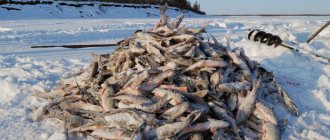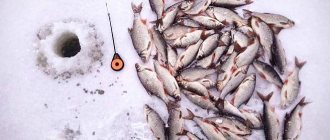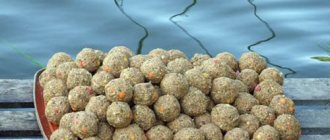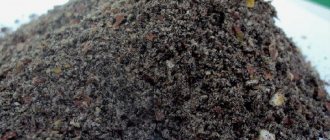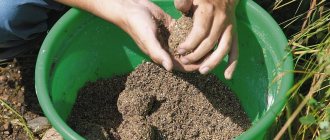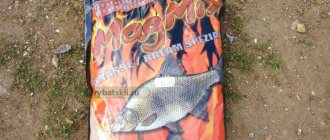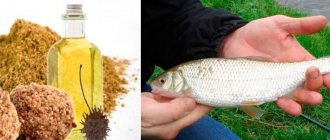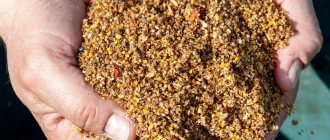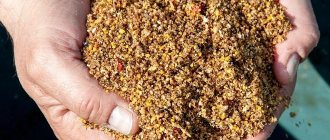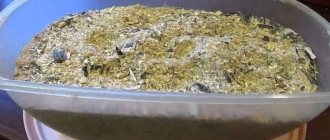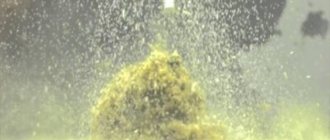Features of feeding roach in spring
- The composition must be selected in accordance with the current conditions and the state of the fish; any high-calorie ingredients are completely excluded from it, since they will quickly saturate the fish, whose metabolic processes in the body have slowed down after winter.
- The use of attractants is encouraged, but avoidance of overly strong and pungent aroma, which will have the opposite effect and scare away potential prey.
- The portions used should be kept to a minimum as the main goal is to attract the roach's attention rather than satiate them.
Why do you need bait?
The main task of spring bait is to attract the attention of roaches to the place chosen for fishing. At this time of year, fish gather in schools and actively search for food; if there is no food in a certain area of the reservoir, they quickly move to other places.
Proper use of bait mixtures with the correct composition allows you to detain a school of roach in a selected area for a long period of time.
Basic requirements for bait for roach in spring
To achieve the desired result, you will have to take into account not only the fishing method and the composition of the mixture, but also the conditions in which fishing is carried out, they determine the main requirements for bait. The most significant factors are discussed in more detail below.
Water color
Floods and active snow melting in early spring lead to a change in the color of the water, it becomes more cloudy, which negatively affects visibility.
For this reason, the roach uses its sense of smell in the process of searching for food, and its senses associated with the sensation of water are also heightened. The exception is fish that try to stay in shallow water, where the water remains relatively clear.
The color of the water also determines the following fishing features that must be taken into account:
- The color of the dorsal part of the roach depends on the quality of the water and the type of soil in the reservoir. In muddy areas, darker specimens are found, and in places with a lot of underwater vegetation, fish with a greenish tint to their backs usually live. These features are due to the fact that roach is a desirable prey for many predators, so it is forced to camouflage itself well. For the same reason, it will pay less attention to a large amount of light-colored bait, against which it will stand out in color and lose its reliable camouflage.
- In conditions of extremely poor visibility, roaches often still actively react to light-colored bait. This is evidenced by many anglers who have noted a significant increase in the number of bites when using maggots as the main bait. However, as soon as it was replaced by bloodworms, the bite immediately began to deteriorate.
- Towards the end of spring and the beginning of the summer season, roach begin to respond more readily to dark food, as water transparency improves.
Based on the listed behavioral features of roach, we can conclude: regardless of the components included in the bait mixture, it should not stand out in color when it hits the bottom surface, otherwise there is a risk that the prey will not pay any attention to it.
Many fishermen solve this problem quite simply: if, after arriving at the pond, it turns out that the bait is too light in color, then it can be artificially darkened with the help of black soil.
Composition of bait mixture for roach
The composition of the mixture is one of the most important factors on which its effectiveness depends. The components are selected in such a way that prey is attracted to the fishing point in the following three ways:
- The visual method involves leaving a visible dusty trail that will be noticeable to fish and will attract fish from a great distance.
- An aroma that attracts roaches to the baited area of the reservoir, but not too strong so as not to scare them away. This smell may be subtle to humans, but in water it spreads over an impressive distance as the mixture dissolves.
- Taste attractive to prey.
A good and high-quality bait mixture must necessarily include the following components:
- The main part, consisting of crushed crackers, cereals and seeds, which are mixed to obtain a homogeneous mixture. Its task will be to create a cloud that the roach will notice from a long distance and rush to the feeding area.
- Feed part, which includes cereal crops that undergo pre-cooking, which makes them more aromatic and appetizing; as well as larvae, worms and other animal feed. Without these components, it will not be possible to delay the attracted prey for a long time, since interest in the main part fades very quickly.
- Adhesive components necessary to bind other bait ingredients. Sugar, flour or starch may be used to perform these functions.
- A small amount of aromatic additives, especially when fishing in muddy water with poor visibility.
- Colorants necessary for additional visual attraction.
Proportions
Correctly determined proportions are another significant factor that determines how long the attracted flock of prey will remain in the feeding area. This concerns the ratio of the dusty part of the mixture, which leaves a noticeable mark in the reservoir, and the components that will go directly into food.
The proportions are determined individually depending on the expected size of the prey: when catching large roach, it is necessary to increase the volume of bloodworms and finely chopped maggots, reducing the amount of dusty components.
When fishing for small or medium-sized fish, you should follow the opposite rule, reducing the amount of real food so as not to cause oversaturation, which will negatively affect the number of bites.
Features of consistency
The consistency of the mixture is no less important, since it will affect the effectiveness of feeding the selected point.
It is determined depending on the fishing conditions, the basic rules are as follows:
- When fishing in areas of a reservoir with a rapid current, it is necessary to increase the amount of sugar, flour or starch. In this case, the consistency will be more viscous and sticky, so the mixture will not wash off in a few minutes.
- When fishing in areas with significant depth, a small amount of clay is added to the mixture, which makes it heavier. This will not only prevent it from being carried away by the current, but will also contribute to faster immersion.
- When fishing in shallow water or in areas of a reservoir with standing water, the amount of adhesive components is reduced to a minimum. In this case, it will be enough that the mixture can be thrown to the selected point.
Nutritional value of mixtures
The last important feature is the nutritional value of the bait: as already mentioned, it should attract roaches and keep them in the chosen area, but not satiate them.
You can artificially reduce the nutritional value of the mixture in the following ways:
- Add sand to the bait, which should be 30-50% of the total volume.
- Instead of sand, you can use chernozem if there is a need to darken a mixture that is too light.
When using sand to reduce nutritional value, the following rules should be observed:
- It is better to take sand from natural conditions, since the options offered by fishing stores are often too dry.
- The sand is first poured onto a wet towel; after 2-3 hours it will be well moistened.
- Sand is not added to the composition in advance, but immediately before the start of complementary feeding, since otherwise it will have time to dry out, which will negatively affect the quality of the mixture.
How to feed crucian carp depending on the type of reservoir?
It is unlikely that it will be possible to say unequivocally which bait for crucian carp is better in the spring. There are quite a few different factors that can affect fishing in one way or another.
One of these factors is the conditions of the reservoir. If you are catching crucian carp on a pond, the bait should have a loose and light consistency so that when it reaches the bottom it does not sink into the silt. In rivers where there is a current, the bait should be viscous enough so that it can remain unwashed for some time.
The presence or absence of other fish in the reservoir is also of great importance in preparing bait for crucian carp. For example, for fishing on lakes where only one crucian carp lives and there are no other fish, you can prepare one of the most effective baits for crucian carp - a mixture of yogurt, soil and breadcrumbs.
Practice has proven that fermented milk products cause crucian carp an incredible desire to eat, but at the same time, the earth present in the composition will not allow them to become oversaturated.
This bait for crucian carp in the spring is completely unsuitable for those reservoirs where other small fish live with them. Due to the content of yogurt in the complementary food mixture, when throwing balls, a small cloud will form, which can attract schools of small fish. These fish will not only interfere with fishing, but can even discourage the crucian carp from this baited place.
Consequently, in ordinary reservoirs, where other underwater inhabitants live together with crucian carp, it is necessary to select completely different compositions for bait. Here the mixture needs to include corn, rolled oats, pearl barley and other ingredients that will be beyond the power of small fish, but on the contrary, will be able to attract larger crucian carp.
Buy bait or prepare it yourself?
Today, fishing stores have a wide range of different bait mixtures, but many people prefer to prepare them themselves at home.
This is due to the following advantages and disadvantages of both options:
- Store-bought options with a really high level of quality are quite expensive, but homemade recipes are distinguished by their simplicity.
- Lack of universal options that would be equally effective when fishing in any conditions. Preparing the mixture at home allows you to obtain bait taking into account the characteristics of the reservoir chosen for fishing, which will significantly increase its effectiveness.
DIY bait recipes for roach
Even a novice angler can cope with preparing bait for spring roach fishing, since there is nothing complicated about it. Below we will consider various recipes that allow you to obtain a mixture suitable for various fishing conditions.
Bait recipe for deep fishing
To catch roach located at great depths, it is recommended to use the following bait preparation recipe:
- Mix bread crumbs, corn flour, wheat bran and crushed clay in equal proportions, which must first be dried. If there is no clay, you can use fairly viscous soil.
- Finely grind the cookies or biscuit, the amount should be one part less than the main mixture.
- A small amount of bloodworms and small maggots is added; their volume can be slightly reduced or increased depending on the expected size of the prey.
- Add a small amount of table salt and a small pinch of cumin, which has a pleasant aroma for roaches.
- All components are thoroughly mixed to obtain a homogeneous mass.
Recipe for passive roach
Sometimes the roach has a rather passive behavior and does not want to pay attention to the bait used.
In this case, you need to prepare bait according to the following recipe:
- The base of the mixture is 3 parts rye bran and 2 parts rye crackers, which must first be crushed.
- Add 1 part each of wheat bran, corn flour and hemp seeds to the mixture, which will also need to be crushed.
- Add 0.5 parts each of pigeon droppings and caddis flies, which can be replaced with bloodworms.
- A few pinches of coriander and a small amount of table salt are added, after which the resulting mass should be mixed thoroughly.
Recipe for fishing at shallow depths
If roach fishing occurs at shallow depths, then it is best to use the following bait preparation recipe:
- The basis of the mixture is crackers made from wheat bread. Take 3 parts of this component.
- Cookies are added to the breadcrumbs, which should be pre-crushed. Its quantity should be 1 part less.
- Add 1 part each of corn flakes and cereal.
- Auxiliary components are taken in 0.5 parts, these are sunflower and flax seeds, which are pre-crushed; pigeon droppings; sunflower cake; bloodworm.
- One tablespoon of ground black pepper and several tablespoons of beta-carotene are added to the resulting mixture.
The resulting mixture demonstrates excellent results if prey is caught at a depth of no more than 1.5 meters. It is possible to add a small amount of crushed cloves to the composition, in which case it will attract not only roach, but also bream.
Salapinskaya porridge
Salapin porridge is a good bait option for roaches, especially when using a feeder as the main tackle
The detailed recipe for its preparation is described below:
- You need to put a 4-5 liter pan on the fire, pour 4.5 cups of water into it.
- You need to wait until the water boils, after which no more than half a mug of pearl barley is poured into it.
- Now you will need to monitor the cooking process, as soon as the water becomes cloudy and the edges of the grains noticeably darken, you need to start mixing the bait, gradually pouring a mug of millet into it.
- After a few minutes, the main aromatic components are added: two tablespoons of sunflower oil and no more than 15 grams of vanillin.
- The porridge is thoroughly mixed, after which it must be left on low heat for further cooking.
- When holes appear in the cooked mixture and the water disappears, remove the pan from the heat and cover it with a lid.
- After 20 minutes, inspect the porridge: if a small amount of water remains, it must be drained.
- Now add a mug of barley grits and 1.5 mugs of corn grits, the porridge is mixed again.
The result should be a crumbly porridge that will serve as an effective bait for spring roach. If its friability is not sufficient, it means that the proportions of the ingredients were chosen incorrectly, in which case you will need to add more cereal.
Recipe for passive roach
Ingredients:
- rye bran – 3 parts;
- crushed rye crackers - 2 parts;
- wheat bran – 1 part;
- crushed hemp seeds - 1 part;
- corn flour – 1 part;
- bloodworm or caddisfly - 0.5 parts;
- pigeon droppings – 0.5 parts;
- salt – 0.2 parts;
- coriander – 2 pinches.
Do-it-yourself bait for roach in early spring from these ingredients copes well with its role in clear water during periods of low fish activity.
The recipes given are not mandatory, they are intended to show what you can use to prepare a bait mixture and what to pay attention to.
Additives to bait
The most common additives for bait are various dyes, flavors and pigeon droppings. The features of their use are discussed below.
The best flavors for roach fishing
Aromatic additives are included in the composition with extreme caution, since it is better not to add them than to transfer them and scare away potential prey from the fishing spot.
The most effective flavors are those with a light and natural scent, so it is recommended to use the following components:
- Ground black pepper.
- Almond.
- Fragrant sunflower oil.
- Ground hemp or sunflower seeds.
- Chopped cloves.
- Vanillin.
Pigeon droppings
Another common additive is dry pigeon droppings, which have a gluing effect and also help stimulate the roach’s appetite.
However, it must meet the following requirements:
- Only poultry droppings are suitable for adding to the bait mixture.
- Corn, flax, hemp or sunflower seeds are specially added to the birds' diet. The resulting droppings acquire special properties due to the peculiarities of the functioning of the digestive system of pigeons.
Dyes and coloring of bait
Dyes are necessary to provide a shade of the mixture that will be closest to the color of the bottom surface. For these purposes, you can use chernozem, beta-keratin or rose hips, which are pre-dried and crushed.
It is best to avoid using pigments that are too bright and conspicuous, as they can scare off cautious and timid prey.
Feeding techniques and tactics
The technique of feeding roaches is quite simple; it is carried out according to the following algorithm of actions:
- Several balls are molded from the mixture, the diameter of which corresponds to medium-sized oranges.
- The molded balls are thrown into the pond, after which you can begin collecting and preparing gear.
- After all preparations are completed, you can feed the prey, but the balls should be small, otherwise there is a risk of interrupting its appetite.
How to properly feed roach during the current?
Feeding during the current is carried out according to a similar scheme, but additional rules must be taken into account:
- Casting the bait mixture should be done upstream. The nozzle with hooks should be located lower, since the flow of water will gradually wash away the bait and create a stream that will be directed to the fishing point.
- The presence of turbulence and the strength of the water flow are important features of the flow that also need to be taken into account. It may be necessary to increase the viscosity of the mixture; for this, ordinary earth is added to its composition.
Spring feeding tactics and choice of location
The choice of bait and the right starting point for bait can determine your fishing success!
Choosing a place for bait . We will try to understand and reveal the tactics of feeding on small rivers, the principle of feeding on which is applicable to a large river. If the place is familiar and you know where there is grass and various kinds of snags at the bottom, then you can immediately add bait, but when the area has not been explored, then you first need to look closely at it, and if it is deep or the water is cloudy and nothing is visible, then It is advisable to make several test runs, check the depths, and find a clean bottom where you should throw the bait. Otherwise, according to the law of meanness, the bait ball will fall into a bush of bottom algae, or even roll under a snag.
Usually, first they throw a dense ball the size of a fist 3-4 meters from the shore, the second ball another meter further, the third another meter. There is no particular point in an interval of less than a meter, but there is no need to do more, since you can incorrectly select the stream on which the fish is located. Then you should wait a little and fish each feeding lane in turn. Events can develop according to different scenarios. The most unfavorable one is that nothing bites, and then we wait a maximum of 25-30 minutes and change the place, and perhaps return to this later.
Rarely, but it happens, three feeding lanes work at once, then you need to look at the fish you are catching - if everywhere is of a similar size, then it’s worth feeding one lane in order to collect more fish. Most often, only one path gives fish, which convinces the angler that the strategy being used is correct, and then you can only supplement this stream by throwing one ball every hour and a half.
Often a fisherman encounters other interesting situations. Let's say, during the fishing process, it was discovered that a small roach began to bite along one path, there were a lot of bites, at some point on almost every retrieve, then everything suddenly died down. The fisherman begins to check the neighboring feeding path, which is literally only a meter further (or vice versa - closer), and immediately a wonderful roach appeared one after another or an excellent ide. And what’s interesting is that for some reason the big fish don’t want to go out onto the path where the small fish were biting, although the food is the same and even the depth is similar.
There are generally incomprehensible fishing trips, when small fish periodically bite along a baited path (or several), then if you follow the unfed stream, you will immediately get a bite from some large fish. Then another one, and another! Why this fish does not come out onto the bait path, but stays nearby is a mystery, but it is clearly suitable for the fuss of small things that are actively eating the bait. Perhaps large fish are afraid of plant food that is atypical for the river, when the fish, as they say, is hungry and hungry?
Roach fishing in spring
Spring roach fishing has a whole lot of nuances, this applies not only to the choice of bait, but also to equipment, since it is at this time of year that feeder fishing is most popular.
Bait for catching roach
You can try the following options as bait in the spring:
- A few bloodworms attached to a hook are standard bait to gauge the reaction of prey.
- Maggots or ordinary worms are used if the bloodworms are not of particular interest to the fish.
Catching roach on a feeder
In March and April the chances of successful fishing using a feeder are extremely low, but they increase significantly in May. In early or mid-spring, it is recommended to use feeder gear only in the southern regions, which are characterized by an early thaw.
Below is an example of the most optimal equipment for a roach feeder:
- The length of the rod should be 3.9 meters, this will allow you to make long casts, which is important when fishing for roach at depth.
- Any spinning reel.
- Mono line with a cross-section of 0.2 mm, the color does not matter much.
- Fluorocarbon leader.
Bait for roach and various tackles
For fishing for roach, float and feeder tackle are often used. Many fishermen make the mistake of using the same bait mixture for these types of fishing, since bait for bottom and float fishing differs from each other in several performance characteristics.
Bait for float fishing
The roach mixture for float fishing in still water should be very light. When moistening it, add a minimum amount of water to the container. The optimal level of moisture will be when the molded ball disintegrates when it hits the water. After breaking the ball, the particles slowly sink to the bottom, attracting roaches. If the bait is over-moistened, the ball, without breaking on the water, will quickly sink to the bottom and will not be able to collect roach in the fishing zone.
Since the amount of bait that is thrown into the fishing point is quite large, you should not get carried away with adding excessive amounts of flavorings. The components included in the roach bait themselves have an attractive aroma for fish.
If we are talking about float fishing for roach in the current, then the principle of operation of complementary foods changes. It consists of heavy soil consisting of earth, clay and sand. The soil keeps nutrient particles from being quickly carried away by a directed flow of water. Fishing in the current involves the formation of dense bait balls, which will quickly reach the bottom and will be eroded by the current for several tens of minutes. The food particles washed out of the balls will gradually collect the roach in the feeding area.
Groundbait for bottom fishing
The mixture for feeder fishing for roach must be active. Having sunk to the bottom, the bait stuffed into the feeder does not just lie on the bottom soil, but actively releases food particles that attract fish, creating a cloud of turbidity around it. This effect can be achieved by adding various ingredients that have buoyant properties:
- dry coconut flakes;
- ground seed peel;
- medium-ground oat flakes.
These ingredients should be added only after the complementary foods have been moistened, when the mixture has completely absorbed the water. Seeing constantly floating particles of food, the roach will definitely become interested and approach the feeder.
The volume of the feeder is small, so a limited amount of food is supplied to the fishing site. When a large flock approaches, in which there are large individuals, the mixture delivered to the point will be quickly eaten, and the roach will leave. To prevent this from happening, feeder baits include a large amount of flavoring. Even after the fish has completely eaten the mixture, a fragrant trail remains in the water, which prevents the school from leaving the feeding area. In addition, the bottom soil is impregnated with aromas, which also helps to retain the roaches in the fed zone.

